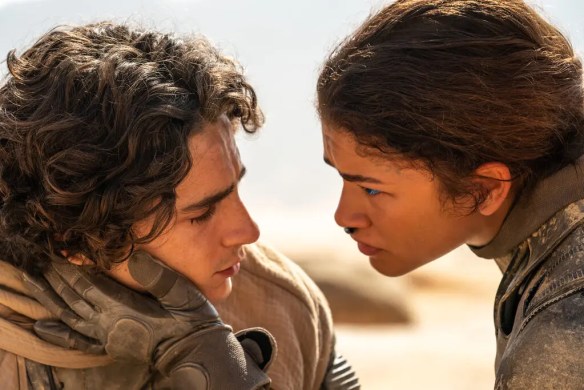
Two movies we’ve seen lately fit nicely on the “not for everybody” shelf. My husband, not being a fan of science fiction, was lukewarm about Dune: Part Two. He might have been less iffy if it weren’t two and three-quarters hours long. I was not bored. Though we generally like movies about World War II and had expected great things of The Zone of Interest, which is an hour shorter than Dune, it seemed kind of endless to me. Here are the deets.
Dune: Part Two
You can’t fault the casting of this film, based on the award-winning Frank Herbert novels of the 1960s, which I remember fondly. Directed by Denis Villeneuve, the movie’s cast is impeccable (trailer). Timothèe Chalamet is hero Paul Atreides, Zandaya is his main squeeze. Along with them are Javier Barden, Austin Butler, Josh Brolin, Christopher Walken, Charlotte Rampling, and Stellan Skarsgård, among many others probably well known to hipper audiences. The makeup of the shaved-head, waxen-skinned bad guys, the Harkonnen clan, were truly creepy. Skarsgård as the chief Harkonnen needed three hours of makeup every day he was on set. He was bulked out to the point he was almost unrecognizable, unless he was posing as the “hookah-smoking caterpillar” from Alice’s Adventures in Wonderland, a comparison that occurred to me (consciously, at least) before I realized he also smoked a hookah.


The special effects were transporting, especially the worm-surfing, and I wasn’t surprised that the non-desert filming took place in Hungary. There was a sleek Central European brutalist vibe about the Harkonnen’s dwellings.
And it definitely sets you up for Dune: Part Three.
Rotten Tomatoes critics rating: 93%; audiences: 95%.

The Zone of Interest
Based incredibly loosely on a novel by Martin Amis, this is the story of a real-life person, commandant of Auschwitz, Rudolf Hōss, and his wife Hedwig, directed by Jonathan Glazer (trailer). On the surface, if you can ignore the constant rumbling (well-earned Academy Award for sound design) of who-knows-what horrible machinery on the other side of the wall, the couple, with their four children and servants lead a perfectly normal middle-class life.
But of course the situation is not even a bit normal, and they can only lead that life (her, in particular), by absolutely denying the reality of what is going on around them. Their older son is playing with teeth—oh, sure. A fabulous fur coat arrives in a pillowcase—par for the course. Her beautiful garden—“I had help, of course.” Yes, and we know who that help was. Just as we know who their skittish servant is. And the woman Rudolf rapes.
Hōss is played by Christian Friedel and Hedwig by Sandra Hüller (who also played in the Oscar-nominated Anatomy of a Fall). She is amazing, conveying so much, so seemingly effortlessly.Rotten Tomatoes critics rating: 93%; audiences: 78%.









 Fiction editor
Fiction editor  Guest-reviewer David Sherr gives 5 stars to this 10-part Amazon Studio Series production, which he binge-watched one recent weekend. Says David:
Guest-reviewer David Sherr gives 5 stars to this 10-part Amazon Studio Series production, which he binge-watched one recent weekend. Says David: